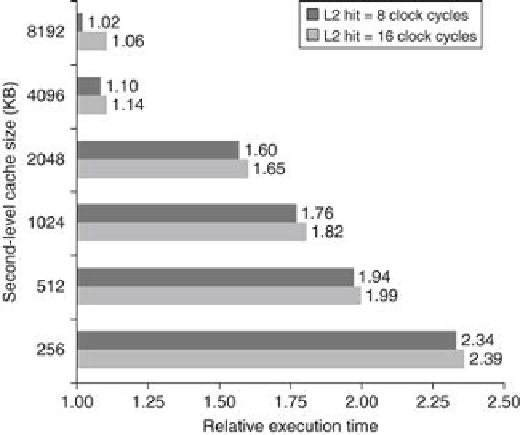Hardware Reference
In-Depth Information
FIGURE B.15
Relative execution time by second-level cache size
. The two bars are for
different clock cycles for an L2 cache hit. The reference execution time of 1.00 is for an 8192
KB second-level cache with a 1-clock-cycle latency on a second-level hit. These data were
collected the same way as in
Figure B.14
,
using a simulator to imitate the Alpha 21264.
With these definitions in place, we can consider the parameters of second-level caches. The
foremost difference between the two levels is that the speed of the first-level cache affects the
clock rate of the processor, while the speed of the second-level cache only affects the miss pen-
alty of the first-level cache. Thus, we can consider many alternatives in the second-level cache
that would be ill chosen for the first-level cache. There are two major questions for the design
of the second-level cache: Will it lower the average memory access time portion of the CPI,
and how much does it cost?
The initial decision is the size of a second-level cache. Since everything in the first-level
cache is likely to be in the second-level cache, the second-level cache should be much bigger
than the irst. If second-level caches are just a litle bigger, the local miss rate will be high.
This observation inspires the design of huge second-level caches—the size of main memory in
older computers!
One question is whether set associativity makes more sense for second-level caches.
Example
Given the data below, what is the impact of second-level cache associativity on
its miss penalty?
■ Hit time
L2
for direct mapped = 10 clock cycles.
■ Two-way set associativity increases hit time by 0.1 clock cycle to 10.1 clock
cycles.


Search WWH ::

Custom Search